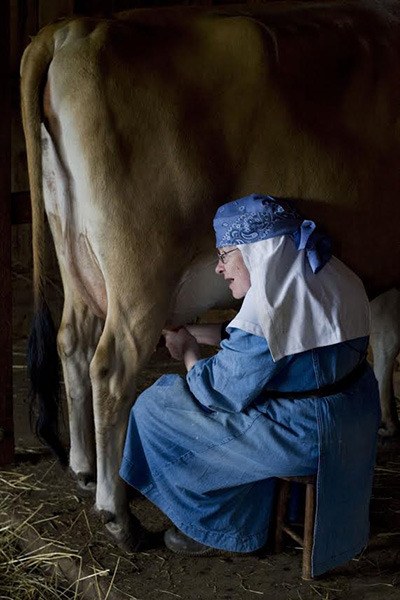by MEREDITH M. GRIFFITH
Sounder contributor
To hear Tari Gunstone tell it, everything began with “The Cheese Nun” of Connecticut, Sister Noella Marcellino.
“She’s a microbiologist, so she really knows her stuff,” says Gunstone, this summer’s “cheese apprentice” at Shaw Island’s Our Lady of the Rock Benedictine monastery.
Marcellino shared her expertise with the Shaw monastery’s Mother Prioress (Mother Thérese), and now shoppers at the Orcas Farmers’ Market can enjoy artisan farmstead cheeses ripened from the raw milk of the monastery’s two Jersey cows.
This is the first time the monastery’s cheeses have been sold anywhere outside of Shaw.
Gunstone, a native of Portland, Ore., is a professional photographer who chose an internship at Our Lady of the Rock as the path to a perfect summer.
“I’ve always considered myself a spiritual seeker,” she said. “There’s something about monasticism that I’m drawn to; the self-denial of consumerism and the pettiness of the outside world is intriguing to me. I’m trying to make my life more contemplative and inward-focused.”
Gunstone hopes to someday create a book photo-documenting the monastic life in a wide variety of monasteries across the country. And since her family used to summer in the San Juans on her parents’ boat, she knew the islands were a beautiful place to begin.
 Based on Gunstone’s interests, the seven “mothers” of the monastery assigned her to cheese-making and caring for the monastery’s Cotswold sheep during lambing season. Her fellow intern, Holly Kemp, has been dubbed “The Fiber Queen” due to her interest in working with wool. The mothers also raise Highland cattle, alpacas, llamas, chickens and turkeys.
Based on Gunstone’s interests, the seven “mothers” of the monastery assigned her to cheese-making and caring for the monastery’s Cotswold sheep during lambing season. Her fellow intern, Holly Kemp, has been dubbed “The Fiber Queen” due to her interest in working with wool. The mothers also raise Highland cattle, alpacas, llamas, chickens and turkeys.
Gunstone said she’s really enjoyed the monastery’s approach to her internship.
“It’s been really amazing to experience the mothers learning to trust me and give me responsibility with the farm work,” she said. “They really allow for a lot of autonomy with the work.”
She said the lack of micro-management has allowed her to grow and learn through trial and error.
Cheese was once traditionally aged in caves, but the monastery’s cave is too wet for cheese-making. So the mothers use a full-sized wine cooler to maintain a steady 55 degrees. The simple farmstead cheese wheels are made using only “a bit of salt” and vegetable rennet, no mold or added cultures.
“The cheese just takes on the natural flavors of the milk that day and the molds that ripen on the outside,” said Gunstone. “Each one is different.”
It takes four gallons of milk to create three pounds of aged cheese, and though the cheese is made weekly, it must age 60 days before sale. The cheeses are regularly sold at the monastery and the Shaw general store.
Gunstone said she is enjoying her experience of the monastic culture.
“It’s a lifestyle and a community that almost feels like it could go extinct,” she expressed. “I think it’s a draw in my generation to get back to the root of things [and care] less about the rat race, and I think monastics do that really well.”
“Ultimately,” she added, “my favorite experience is living on Shaw Island – to walk into the woods and be totally alone, or spend an afternoon at the beach totally by myself.”
Read more about nuns and cheese
PBS released a documentary about Marcellino entitled “The Cheese Nun” in 2006.
Find out more at http://www.amazon.com/The-Cheese-Sister-Noella-Marcellino/dp/B000FGG62K.



